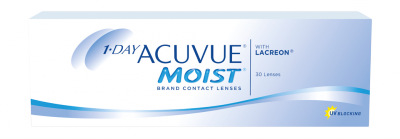You are currently not taking any of our courses.
Educate both your staff and your customers with our different courses!
For patients who want a long-lasting cushion of moisture5, 1-DAY ACUVUE® MOIST is unbeaten in comfort# in its category.

–0.50D to –6.00D (0.25D steps)
–6.50D to –12.00D (0.50D steps)
+0.50D to +6.00D (0.25D steps)
Parameters
8.5 mm base curve/14.2 mm diameter
9.0 mm base curve/14.2 mm diameter
Daily wear, 1-day replacement
| Lens material | etafilcon A |
| Technology | Internal wetting agent Polyvinyl pyrrolidone (PVP) using LACREON® Technology |
| Oxygen transmissibility (Dk/t):5 | 25.5 x 10-9 |
| Oxygen % available to central cornea:6 | 87% |
| Water content | 58% |
| UV-blocker:* | 98.8% UVB and 85.1% UVA (Class 2) |
| Center thickness at-3.00D (mm) | 0.084 |
| Inside-out mark | Yes (123) |
| Visibility tint | Yes |
| Package size | 30, 90, 180 lenses |
*All ACUVUE® Brand Contact Lenses have Class 1 or Class 2 UV-blocking to help provide protection against transmission of harmful UV radiation to the cornea and into the eye. UV-absorbing contact lenses are NOT substitutes for protective UV-absorbing eyewear such as UV-absorbing goggles or sunglasses because they do not completely cover the eye and surrounding area. UV transmission measured with -1.00D lens.
Packing solution contains boric acid and disodium tetraborate (sodium borate) to control the pH of the solution.
1. Sheardown H, Liu L and Jones L. Chemical characterisation of 1-DAY ACUVUE® MOIST and 1-DAY ACUVUE® contact lenses. Invest Ophthalmol Vis Sci 2006;47: E-Abstract 2388.
2. Data on file JJVC 2002 and 2012.
3. Hayes V, Schnider C and Veys J. An evaluation of 1-day disposable contact lens wear in a population of allergy sufferers. CLAE 2003 Jun;26(2):85-93.
4. JJVC data on file 2011
5. Oxygen transmissibility at the centre of a -3.00D lens using boundary-corrected, edge-corrected Dk values. Units: (cm/sec) (ml O2/ml x mm Hg) at 35° C. Dk determined via polarographic method.
6. Oxygen flux - % available to central cornea (open eye) and compared to 100% with no lens.
1-DAY ACUVUE® MOIST integrates EYE-INSPIRED™ Innovations for an exceptional vision experience within reach1†.
LACREON® is a technology that retains moisture for up to 20 hours.5
Lab testing shows, 1-DAY ACUVUE® MOIST protects one of the eye’s natural defences.6** In a year-long observational study, there were no serious or infiltrative events in 570 patients wearing lenses.2††
1-DAY ACUVUE® MOIST is readily available across its family of lenses with comprehensive parameters for a satisfying vision experience.3‡‡
Packing solution contains boric acid and disodium tetraborate (sodium borate) to control the pH of the solution.
*Source: Euromonitor International Limited, based on research conducted in December 2021, "world" and "globally" represent markets accounting for 76% of total daily disposable contact lenses in 2020 (retail sales).
# ClinicalTrials.gov is a website maintained by the NIH. The 11 clinical studies evaluated subjective comfort as a primary or secondary endpoint for 1-DAY ACUVUE MOIST brand family (spherical ONLY) contact lenses vs. competitors’ products. Review conducted as of October 31, 2022.
†All ACUVUE® contact lenses have Class 1 or Class 2 UV-blocking to help provide protection against transmission of harmful UV radiation to the cornea and into the eye. UV-absorbing contact lenses are NOT substitutes for protective UV-absorbing eyewear such as UV-absorbing goggles or sunglasses because they do not completely cover the eye and surrounding area. UV transmission measured with -1.00 lens.
§In a year-long observational/surveillance registry that relied on patient reports of symptomatic adverse events that would have led them to seek clinical care, no symptomatic infiltrative events or serious adverse events were reported. These results should be considered in conjunction with other clinical results on the safety and efficacy of daily disposable etafilcon A contact lenses, which also generally show low rates of such events. Although no symptomatic infiltrative events were reported in this study, such events can and have occurred with daily disposable lenses, including 1-DAY ACUVUE® MOIST, as noted in the product labeling.
**Based on in-vitro data, clinical studies have not been done directly linking differences in lysozyme profile with specific clinical benefits.
††This observational/surveillance registry relied on patient reports of symptomatic adverse events that led them to seek clinical care. These results should be considered in conjunction with other clinical results on the safety and efficacy of daily disposable etafilcon A contact lenses, which also generally show low rates of such events. Although no symptomatic infiltrative events were reported in this study, such events can and have occurred with daily disposable lenses, including 1-DAY ACUVUE® MOIST, as noted in the product labeling.
‡‡Based on publicly available manufacturer information as of March 2020.
1. JJV Data on File 2020. ACUVUE® Brand - Eye-InspiredTM Innovations.
2. JJV Data on File, 2022. 1-DAY ACUVUE® MOIST Claims from the TEMPO Observational Registry.
3. JJV Data on File 2020. 1-DAY ACUVUE® MOIST Family Parameters Coverage
4. JJV Data on File 2022. Material Properties: 1-DAY ACUVUE® MOIST, 1-DAY ACUVUE® TruEye®, ACUVUE® OASYS 1-Day with HydraLuxe® Technology and ACUVUE® OASYS MAX 1-Day with TearStable Technology Brand Contact Lenses.
5. JJV Data on File 2021. Dual Action Technology and “Cushion of Moisture” Description for 1-DAY ACUVUE® MOIST Brand Family of Contact Lenses.
6. Omali NB, Subbaraman L, Heynen M, et al. Surface versus bulk activity of lysozyme deposited on hydrogel contact lens materials in vitro. Contact Lens Anterior Eye. 2018;41(4):329-334.doi: 10.1016/j.clae.2018.03.005.